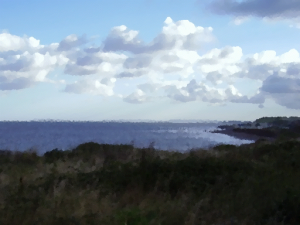Lukpanic languages

The Lukpanic family of languages was found along a stretch of the coast of Western Peilaš until ca. -200 YP, in half a dozen city-states of similar size and culture. This sophisticated urban culture arose ca. -1600, and its language, Proto-Lukpanic, was spoken ca. -1200, but the speakers may have come to the area about a millennium before this. Lukpanic is one branch of the broader Paic phylum, the other members being spoken by hunter-gatherer or garden agriculturalist tribes scattered across the northwestern part of the continent.
The proto-language was unwritten, though the speakers made use of numeral glyphs and ideographic symbols, for ritual and commercial purposes. Writing proper was picked up via contact with the greater Xšali sphere ca. -1000; formally, the result was a Lukpanic-Xšali hybrid. The Coastal Western-speakers first used Lukpanic as the written norm, when they cared to write. The script was adapted in various ways to their own languages some centuries later.
The term Lukpanic is derived from the Proto-speakers' self-appellation Gbagba Lukpani, "the people facing toward the sea," where gbagba means "people; nation," lu- means "ocean," and -kpani is a directional suffix meaning "facing towards." They also called themselves the Lukpanab, using an agentive form. They usually referred to their language, however, as Hu Mitali -- "flowing speech."
The proto-language differentiated into a dozen very similar tongues which were encountered by Coastal Western peoples when they began to wander into the area. By the year -200 the Lukpanic languages had died out in their core territory, having been replaced by Western tongues via gradual absorption. Their urban and maritime culture continued in a fairly similar form, though with heavy Western influence.
Lukpanic languages remained in the western hinterlands and in the island city-state of Poalugbum. The latter came to be known as a multiethnic crossroads - and a den of vice - but the locals spoke their unique, strange dialect, laconically known as Fu.
At least 25% of Coastal Western vocabulary is Lukpanic in origin.
Overview
- Proto-Lukpanic (Lukpanic coast, c. -1500 YP - Dunomapuka)
- Ru Negwẽ (Naəgbum, c. -900 YP - Alces)
- Fu Pitão (Kpitamoa, c. -750 YP - Cedh)
- Hu Shĩmyashta (Siŋmeasita, c. -700 YP - Corumayas)
- Fu (Poalugbum, c. 100 YP - Dunomapuka - descended from a dialect similar to Hu Shĩmyashta)
- U Ishe (Isi, c. -750 YP - thedukeofnuke)
- U Adonupu (Doanu, c. -500 YP - CatDoom)
- O Ayōndui (Yōndui islands, c. -300 YP - Cedh)
Dialects
By the year -600 or so, Lukpanic had differentiated into various recognizable dialects, the most prestigious being those of the central cities of Isi and Siŋmeasita. Variation between the dialects was mostly phonological and lexical; this variation is reflected in the form of words borrowed into the Coastal Western languages. A comparative table is here included to illustrate the major sound changes that had occurred since the proto-language.
The Poalugbum dialect, as listed, is contemporaneous with the other dialects, and can be thought of as Proto-Fu; Fu is the language descended from it.
| gloss | Proto | Eaunutul | Doanu | Isi | Siŋmeasita | Kpitamoa | Naəgbum | Poalugbum | Fu |
|---|---|---|---|---|---|---|---|---|---|
| "cloud" | toaba | tuəbə | toba | toba | twaba | towa | toaba | twava | twav |
| "liver" | kpugba | kugə | kpugba | kuba | kubba | kuba | kʷugʷa | kubba | kup |
| "death" | eadami | iədami | edɑmi | edɒme | yadãi | eyãi | eadãi | yalẽ | jan |
| "whale" | gitib | zēte | gitiw | ɦichib | gitsib | gitib | gitəb | gitsib | gičp |
| "hair" | huəb | ō | ow | ob | hub | ɸub | ʀuəb | fuob | fwop |
| "rib" | taəsa | taihə | taiza | taza | tasa | tasa | təsa | təsa | tüs |
| "white" | savu | havo | sɑwu | sɒβu | savu | sau | sau | savu | sav |
| autonym | lukpani | rukani | lukpɑni | lupɒne | luppãi | lupãi | lukʷãi | luttẽ | ɽut |
These dialects are listed (mostly) west to east.